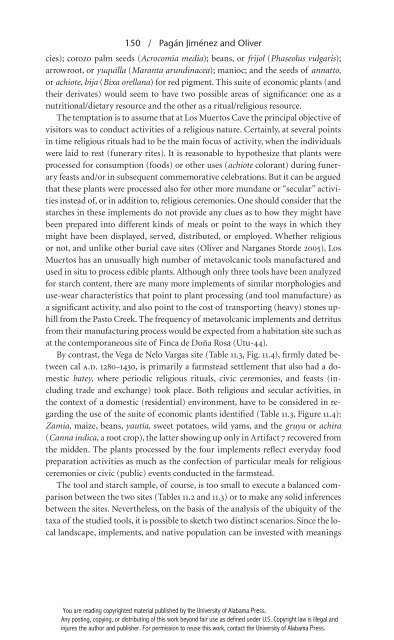Crossing the Borders: New Methods and Techniques in the Study of Archaeological Materials from the Caribbean
by Corrine L. Hoffman, et. al.
by Corrine L. Hoffman, et. al.
Create successful ePaper yourself
Turn your PDF publications into a flip-book with our unique Google optimized e-Paper software.
150 / Pagán Jiménez <strong>and</strong> Oliver<br />
cies); corozo palm seeds (Acrocomia media); beans, or frijol (Phaseolus vulgaris);<br />
arrowroot, or yuquilla (Maranta arund<strong>in</strong>acea); manioc; <strong>and</strong> <strong>the</strong> seeds <strong>of</strong> annatto,<br />
or achiote, bija (Bixa orellana) for red pigment. This suite <strong>of</strong> economic plants (<strong>and</strong><br />
<strong>the</strong>ir derivates) would seem to have two possible areas <strong>of</strong> significance: one as a<br />
nutritional/ dietary resource <strong>and</strong> <strong>the</strong> o<strong>the</strong>r as a ritual/ religious resource.<br />
The temptation is to assume that at Los Muertos Cave <strong>the</strong> pr<strong>in</strong>cipal objective <strong>of</strong><br />
visitors was to conduct activities <strong>of</strong> a religious nature. Certa<strong>in</strong>ly, at several po<strong>in</strong>ts<br />
<strong>in</strong> time religious rituals had to be <strong>the</strong> ma<strong>in</strong> focus <strong>of</strong> activity, when <strong>the</strong> <strong>in</strong>dividuals<br />
were laid to rest (funerary rites). It is reasonable to hypo<strong>the</strong>size that plants were<br />
processed for consumption (foods) or o<strong>the</strong>r uses (achiote colorant) dur<strong>in</strong>g funerary<br />
feasts <strong>and</strong>/ or <strong>in</strong> subsequent commemorative celebrations. But it can be argued<br />
that <strong>the</strong>se plants were processed also for o<strong>the</strong>r more mundane or “secular” activities<br />
<strong>in</strong>stead <strong>of</strong>, or <strong>in</strong> addition to, religious ceremonies. One should consider that <strong>the</strong><br />
starches <strong>in</strong> <strong>the</strong>se implements do not provide any clues as to how <strong>the</strong>y might have<br />
been prepared <strong>in</strong>to different k<strong>in</strong>ds <strong>of</strong> meals or po<strong>in</strong>t to <strong>the</strong> ways <strong>in</strong> which <strong>the</strong>y<br />
might have been displayed, served, distributed, or employed. Whe<strong>the</strong>r religious<br />
or not, <strong>and</strong> unlike o<strong>the</strong>r burial cave sites (Oliver <strong>and</strong> Narganes Storde 2005), Los<br />
Muertos has an unusually high number <strong>of</strong> metavolcanic tools manufactured <strong>and</strong><br />
used <strong>in</strong> situ to process edible plants. Although only three tools have been analyzed<br />
for starch content, <strong>the</strong>re are many more implements <strong>of</strong> similar morphologies <strong>and</strong><br />
use- wear characteristics that po<strong>in</strong>t to plant process<strong>in</strong>g (<strong>and</strong> tool manufacture) as<br />
a significant activity, <strong>and</strong> also po<strong>in</strong>t to <strong>the</strong> cost <strong>of</strong> transport<strong>in</strong>g (heavy) stones uphill<br />
<strong>from</strong> <strong>the</strong> Pasto Creek. The frequency <strong>of</strong> metavolcanic implements <strong>and</strong> detritus<br />
<strong>from</strong> <strong>the</strong>ir manufactur<strong>in</strong>g process would be expected <strong>from</strong> a habitation site such as<br />
at <strong>the</strong> contemporaneous site <strong>of</strong> F<strong>in</strong>ca de Doña Rosa (Utu-44).<br />
By contrast, <strong>the</strong> Vega de Nelo Vargas site (Table 11.3, Fig. 11.4), firmly dated between<br />
cal a.d. 1280–1430, is primarily a farmstead settlement that also had a domestic<br />
batey, where periodic religious rituals, civic ceremonies, <strong>and</strong> feasts (<strong>in</strong>clud<strong>in</strong>g<br />
trade <strong>and</strong> exchange) took place. Both religious <strong>and</strong> secular activities, <strong>in</strong><br />
<strong>the</strong> context <strong>of</strong> a domestic (residential) environment, have to be considered <strong>in</strong> regard<strong>in</strong>g<br />
<strong>the</strong> use <strong>of</strong> <strong>the</strong> suite <strong>of</strong> economic plants identified (Table 11.3, Figure 11.4):<br />
Zamia, maize, beans, yautía, sweet potatoes, wild yams, <strong>and</strong> <strong>the</strong> gruya or achira<br />
(Canna <strong>in</strong>dica, a root crop), <strong>the</strong> latter show<strong>in</strong>g up only <strong>in</strong> Artifact 7 recovered <strong>from</strong><br />
<strong>the</strong> midden. The plants processed by <strong>the</strong> four implements reflect everyday food<br />
preparation activities as much as <strong>the</strong> confection <strong>of</strong> particular meals for religious<br />
ceremonies or civic (public) events conducted <strong>in</strong> <strong>the</strong> farmstead.<br />
The tool <strong>and</strong> starch sample, <strong>of</strong> course, is too small to execute a balanced comparison<br />
between <strong>the</strong> two sites (Tables 11.2 <strong>and</strong> 11.3) or to make any solid <strong>in</strong>ferences<br />
between <strong>the</strong> sites. Never<strong>the</strong>less, on <strong>the</strong> basis <strong>of</strong> <strong>the</strong> analysis <strong>of</strong> <strong>the</strong> ubiquity <strong>of</strong> <strong>the</strong><br />
taxa <strong>of</strong> <strong>the</strong> studied tools, it is possible to sketch two dist<strong>in</strong>ct scenarios. S<strong>in</strong>ce <strong>the</strong> local<br />
l<strong>and</strong>scape, implements, <strong>and</strong> native population can be <strong>in</strong>vested with mean<strong>in</strong>gs<br />
You are read<strong>in</strong>g copyrighted material published by <strong>the</strong> University <strong>of</strong> Alabama Press.<br />
Any post<strong>in</strong>g, copy<strong>in</strong>g, or distribut<strong>in</strong>g <strong>of</strong> this work beyond fair use as def<strong>in</strong>ed under U.S. Copyright law is illegal <strong>and</strong><br />
<strong>in</strong>jures <strong>the</strong> author <strong>and</strong> publisher. For permission to reuse this work, contact <strong>the</strong> University <strong>of</strong> Alabama Press.


















